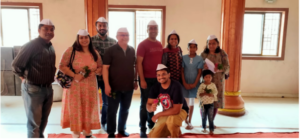While interacting with a fellow collaborator last week, I was in for a surprise – this individual, at quite a senior position had absolutely no qualms in sharing that she has been taking online lessons on advanced excel – a simple and powerful tool, yet generally underutilised just because lot of people fail to admit that they don’t know it well. This colleague of mine, is not just feeling much more productive by being able to do things she wasn’t able to do earlier, but also this has helped her towards a new role she is expecting to take up soon. During this lockdown period, I am sure, you would have your own such tales to share – with the plethora of options of webinars, online courses and ed-tech becoming commonplace.
For time being, if we were to shift our memories to a few months back to pre-Covid times, ( seems such a long time back ! ), we all in our respective organisations have been part of several training programs / assessments arranged by our HR colleagues; towards building the overall capability of individuals and in turn for organisation. Or was it capacity building or were these targeted at competence improvement. Too much confusion. Ever wondered about the same?
Capability, Capacity, Competence etc. are words that are often used interchangeably at a lot of places. However, each of them stands for different things. Let’s start with some basic example. A runner may finish a 100m sprint in 20 seconds but with sufficient training have the capability to finish in 12 seconds too. Therefore, capability is an attribute that can be developed, given the right conditions. Capacity refers to current ability, which is to run a 100m race in 20 seconds. Competence is the quality of being functionally adequate or having sufficient knowledge, strength and skill to deliver what is required. Carrying the example forward, if the world championship participants are all in range of 9-12 seconds, currently the runner is not competent for that race.
These words can be applied to individual or organisation.
Why am I discussing these confusing trio of words ?
If capability is a feature that can be developed or improved in an individual/ team/ organisations then what stops organisations to get all necessary training and get fully capable? The answer lies in the research that says, capabilities that individuals / organisations need, evolves with time. Agile individuals / organisations always remain on their toes, and keep sharpening their tools and improving on their capabilities. The idea here is to learn from what such organisations do and what kind of capability building models they use, at fundamental level.
Let me therefore begin by sharing that any personal or organisational growth in capacity is a factor of first measuring one’s existing competence and being aware of competence level one aims at reaching. Once these two are set, capability building can be achieved.
“Know that you don’t know. That is superior” – Lao Tzu, Founder of Taoism
Capability building works at three levels – Knowledge (or cognitive abilities), Skill (or physical abilities) and Attitude (emotional abilities). So, if one is learning facts (eg. Textbooks), that’s developing knowledge capability. If one is learning how to do things, that’s the skills domain and finally, when one is learning about how to form a new or different viewpoint, that’s attitude level. Lately, a lot of management journals are also talking about KASH model where beyond the Knowledge, Attitude and Skills, there’s a fourth element of Habits. However, for capability building perspective, I am choosing to leave the Habits part out.
Based on my career experience, I would be focussing about the relevance of capability building in context of positive social change. In last 15 years, I have travelled across India, SAARC region, Africa and Latin America in relation to work and have come across some fascinating Non-profit organisations delivering some amazing social value. Ironically some of these competent organisations failed to develop their capabilities over time which lead to efficiencies getting diminished and at one stage leading to organisations dying down. The issue had always intrigued me and had been one of the founding principles or raison d’etre for me getting into social entrepreneurship, with the belief that with proper training, coaching, mentoring for the non-profit leadership – a lot of these organisations can be saved from getting into oblivion or help improve their efficiencies. The power of capability building in any of the domains like fundraising, impact communication, governance etc. can actually lead to a large number of beneficiaries being served. The Non-profit sector, like any other, is in a state of rapid change with new technologies coming on one end, newer global challenges emerging to be tackled and at the same time, drastically increasing funding requirements. At NuSocia, we try to fill this gap with our world class training program, customised to local requirements. The aim is to strengthen non-profit organisations including NGOs, CSOs as well as social enterprises.
Moving onto the For-Profit world of corporations; my conversations with CSR leaders, HR leaders and CXOs over the years, made me realise that while they are getting the best possible training for their leadership level employees – about technological advancements, about organisational behaviour or on softer areas like analytical skills or decision making tools, what they are realising is that an ecosystem awareness / social consciousness and emotional maturity are increasingly becoming the capability requirements of pressure roles at the top. Recently I was speaking to a leadership coach Harish Devrajan (Watch Video), who mentioned that Empathetic leadership is not a subject which can be learned from the textbooks and it needs to be lived and experienced, to develop. So true indeed.
While the above two are organisational level capabilities, what we must not miss out is that change happens at individual level. Hence it is necessary to create conversation, share stories, build inspirations and facilitate actions at individual level. A general survey among population reveals that at individual level, there is either an apathy citing social good to be government responsibility or there is ignorance about the ways in which one can contribute. The reason behind this apathy or ignorance is linked to fact that most of us do not realise the power we possess to make small changes that can have lasting impact. Sometimes, our small action, looks too trivial to us to even discuss, for example, waste segregation at home. Sometimes, we think that unless we do big things is not possible. But we also know how clouds are formed by each drop of vapour. Every single story of inspiration / knowledge that one can garner in forms of webinars, podcasts, expert interviews with thought leaders or young social entrepreneurs, is therefore a step in direction of making of that powerful cloud.
At NuSocia, we are mindful that while building capabilities the intention is of empowerment therefore our Capability Building modules begins by establishing current and desired competence levels; aligns the desired state with the organisational vision to ensure sustainability of the program and then finally curate the program to close the capability gaps. Finally, to all my friends in Non profits and For profits, I would like to share a quote from Benjamin Franklin, “Investment in Knowledge always pays the best interest”
Author : Manju Menon (CEO & Co-Founder, NuSocia)




